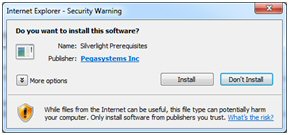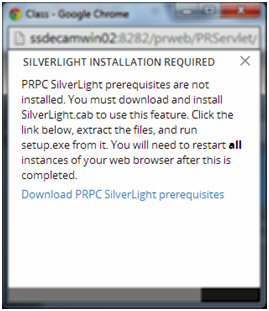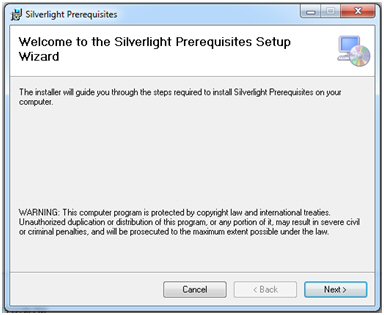Word merge support with Microsoft Silverlight plug-in
Valid from Pega Version 7.1.3
PRPC features that integrate with the Word merge capability are now cross-browser. ActiveX controls (which are only compatible with IE) have been replaced with Microsoft Silverlight. This plug-in must be downloaded separately from Microsoft, as it is not shipped with PRPC.
Some common PRPC features affected by this change include the Application Document Wizard, App Profile, Specifications Landing Page, Specification form, and Case Type Landing Page.
Prior to using these features, Users of PRPC 7.1.3 need to set up their client system(s) as follows:
1. Install Silverlight plug-in
Follow the PRPC prompt to install Silverlight when you attempt to use the Word merge feature:

Or download package directly: www.microsoft.com/silverlight/
2. Install PRPC prerequisites
Microsoft Internet Explorer (IE) browsers automatically detect the need for PRPC prerequisites and will prompt for install:

Non-IE browsers will load a pop-up window when the user attempts to use the Word merge feature. Use the link to manually download PRPC prerequisites:

Extract the .zip file, execute setup.exe and follow the install wizard:

Administrators setting up multiple clients at once may refer to the pzSLpreReqs.cab available in the PRPC 7.1.3 resource kit.
3. Restart browser
Log out of PRPC, close all open sessions and restart your browser.
The PRPC feature integrated with Word merge is now ready for use; Silverlight prompts are no longer displayed.
4. Troubleshooting
Silverlight installation requires access to your file system and a registry setting update to “trust” the associated Verisign certificate. Contact your administrator if you encounter any security or permission errors during this process.
See the PRPC Developer Help for more information on browser setup requirements.
Data Designer lets you explore, develop, and manage the data your application uses
Valid from Pega Version 7.1.7
The Data Designer, new in Pega 7.1.7, is the lens through which you create and manage your application data types, and create properties within the selected data type. The Create Properties wizard is retired, and you now create and manage properties in the Definition tab of the data type you are viewing. You can track how your application uses your data types, and which case types use which data, on the Usage tab. Review the sources for your data types on the Sources tab, and create and manage local data storage for records on the Records tab.
For more information, see About Data Types.
Explore the relationships between data types with the Data Visualizer
Valid from Pega Version 7.1.7
The Data Visualizer, new in Pega 7.1.7, provides a graphical display of the relationships among your application's data types and class types. The map view can help clarify how your application's data works together. When you hover the mouse pointer over an entity in the display, the Data Visualizer highlights the entities with which that entity has a direct relationship.
For more information, see About the Data Visualizer.
New Cassandra connector rules allow applications to use data in BigData stores
Valid from Pega Version 7.1.7
The new Connect Cassandra rule type provides the interface to leverage data in Cassandra data stores. This means that your applications can use large data sets stored in Cassandra data stores. For more information on this connector type, see About Connect Cassandra rules.
New Hbase connector rules allow applications to use data in BigData stores
Valid from Pega Version 7.1.7
The new Connect HBase rule type provides the interface to leverage data in HBase data stores. This means that your applications can use large data sets stored in HBase data stores. For more information on this new rule type, see About Connect HBase rules.
Your application can be a SAML service provider
Valid from Pega Version 7.1.7
You can quickly establish your application as a SAML service provider, with a web SSO profile, SOAP binding, and HTTP redirect binding to support single logout binding. The service is interoperable with Ping Identity, Tivoli Federated Identity Manager, and many other leading identity service providers (ISPs).
PATCH support for REST integrations
Valid from Pega Version 8.2
REST connectors and REST services now include support for integrating with REST APIs that require using the PATCH method. REST integrations that support the PATCH method allow you to make partial updates to individual resources while retaining data that does not require an update. With PATCH support, you no longer need to write complex custom code to integrate with services that require using the PATCH method.
For more information about REST integrations, see Connect REST form - Completing the Methods tab.
Configure REST connectors for standard-compliant endpoints
Valid from Pega Version 8.2
REST connectors now support all standards-compliant endpoint URLs, regardless of how those URLs use query parameters.
This URL support allows you to do the following actions:
- Include repeated query string parameters in a URL.
- Omit a query string parameter if the value of the parameter is empty when you send a request.
- Apply appropriate encoding for different URL components.
For more information about REST connectors, see Connect REST form.
Elasticsearch reports support string comparison operators
Valid from Pega Version 8.2
To improve performance, reports that use string comparison operators in filters can now run queries against Elasticsearch instead of querying the database. The following operators are now supported for Elasticsearch queries.
- Starts with, Ends with, Does not start with, and Does not end with
- Contains and Does not contain
- Greater than, Less than, Greater than or equal, and Less than or equal
In cases where a query cannot be run against Elasticsearch, the query is run against the database, for example, if the query includes a join. To determine if a query was run against Elasticsearch, use the Tracer and enable the Query resolution event type. For more information, see Tracer event types to trace.
OAuth 2.0 support in Integration Designer
Valid from Pega Version 8.2
Integration Designer now supports the configuration of OAuth 2.0 authentication with authorization code and client credential grant types. Use OAuth 2.0 authentication when creating a new data type, replacing a data source, or updating a data source.
For more information about REST integrations, see About Connect REST rules, and for more information about OAuth 2.0 Authentication, see OAuth 2.0 providers.

